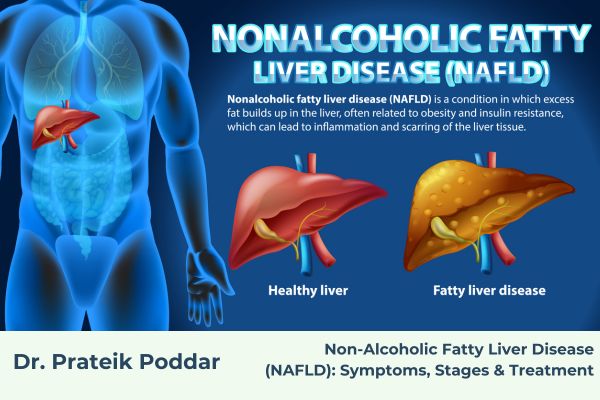Non-Alcoholic Fatty Liver Disease (NAFLD): Symptoms, Stages & Treatment
Expert Insights by Dr. Prateik Poddar
Non-Alcoholic Fatty Liver Disease (NAFLD) is a growing global health concern, affecting individuals due to obesity, diabetes, and unhealthy lifestyle habits. Dr. Prateik Poddar, a leading liver specialist, explains the causes, symptoms, stages, and best treatment options to manage and prevent NAFLD effectively.
What is NAFLD?
NAFLD occurs when excess fat builds up in the liver without alcohol consumption. If left untreated, it can lead to liver inflammation, scarring (fibrosis), and even liver failure. The condition is commonly associated with obesity, high cholesterol, insulin resistance, and metabolic syndrome.
Symptoms of NAFLD
NAFLD is often silent in the early stages, but as the disease progresses, symptoms may include:✔ Fatigue and weakness
✔ Discomfort or pain in the upper right abdomen
✔ Unexplained weight gain or loss
✔ Swelling in the legs and abdomen (ascites) in severe cases
✔ Jaundice (yellowing of the skin and eyes) in advanced stages
Since symptoms may not appear until the later stages, regular liver check-ups are crucial for early detection.
Stages of NAFLD
NAFLD progresses through four key stages:
1. Simple Fatty Liver (Steatosis)
- Excess fat accumulates in the liver, but no significant damage occurs.
- Completely reversible with lifestyle changes.
2. Non-Alcoholic Steatohepatitis (NASH)
- Liver inflammation begins, causing damage to liver cells.
- Higher risk of progression to fibrosis and cirrhosis.
3. Fibrosis (Liver Scarring)
- Chronic inflammation leads to scar tissue formation in the liver.
- Liver function remains intact, but damage starts accumulating.
4. Cirrhosis (Severe Liver Damage)
- Extensive scarring impairs liver function, leading to liver failure or liver cancer.
- Irreversible but can be managed to slow progression.
How is NAFLD Diagnosed?
Dr. Prateik Poddar recommends the following tests for diagnosing NAFLD:
🩺 Liver Function Tests (LFTs): Measures liver enzyme levels.
🩺 Ultrasound or FibroScan: Detects liver fat and scarring.
🩺 Blood Tests: Assess cholesterol, blood sugar, and insulin resistance.
🩺 Liver Biopsy (in severe cases): Determines the extent of liver damage.
Treatment & Management of NAFLD
1. Lifestyle Changes (Most Effective Treatment)
✔ Weight Loss: Losing 5-10% of body weight can significantly reduce liver fat.
✔ Balanced Diet: Follow a Mediterranean diet with vegetables, fruits, whole grains, and healthy fats.
✔ Regular Exercise: 30-45 minutes of moderate activity (walking, cycling, or swimming) daily.
✔ Avoid Sugary & Processed Foods: Reduce intake of refined carbs, sodas, and fried foods.
2. Medications & Medical Supervision
- Diabetes & Cholesterol Medications: Help manage metabolic risk factors.
- Vitamin E & Certain Drugs: May help reduce liver inflammation (under medical guidance).
- Liver Transplant: Required in cases of cirrhosis or liver failure.
3. Regular Monitoring & Check-ups
🔹 Routine liver function tests to track liver health.
🔹 Regular screenings for fibrosis or cirrhosis in high-risk patients.
Final Thoughts
NAFLD is preventable and reversible with early intervention. If you are overweight, diabetic, or have high cholesterol, adopting healthy lifestyle habits is essential for protecting your liver.
For expert guidance on NAFLD diagnosis and treatment, consult Dr. Prateik Poddar today. Early management can prevent severe complications and ensure a healthier life.

